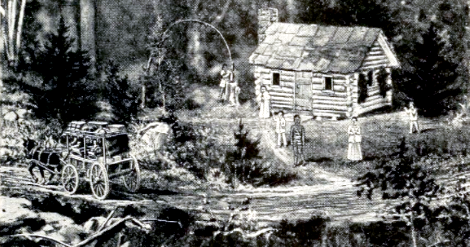Why did anyone bother to build Barkhamsted Lighthouse in the hills of Western Connecticut? According to legend it was a love denied that inspired the village that became known as Barkhamsted Lighthouse.

Barkhamsted Lighthouse (1864) from The story of Connecticut by Lewis Sprague Mills.
Author and educator Lewis S. Mills turned the legend into an epic poem in 1960. According to the story, around 1730 the wealthy Peter Barber of Wethersfield, Conn., ordered his daughter Molly to refuse the hand of her boyfriend and seek out a wealthier man for a husband. She resisted and created a standoff. He locked her in his mansion under guard. She refused to give in, vowing she would not seek out a rich man.
Barkhamsted Lighthouse
After Peter died, James Chaugham caught Molly’s eye. He was a Narragansett Indian. When he proposed, Molly accepted and the two got married. Perhaps to escape criticism of their mixed marriage, the couple moved to western Connecticut and established the town of Barkhamsted Lighthouse.
The community prospered in a small way. The Chaughams had eight children. The town also became home to a number of other poor and mixed-race families. But as more Connecticut people began looking to move north and west in search of available land, Barkhamsted, in its own way, kept thriving.
At one point the area even attracted the man behind Connecticut’s legendary Hitchcock chair. He located a factory in the area. The village prospered for more than 100 years, but it finally died out around 1865. Bigger towns that were easier to reach simply proved more attractive, and today it is an archaeological site.
But why was it called Barkhamsted Lighthouse? Because it served as a beacon on the north-south stagecoach road. The twinkling lights in the houses of the Chaughams and their neighbors assured passengers in the night that they still followed the right path.
Thanks to The Legend of Barkhamsted Lighthouse by Lewis Sprague Mills. This story was updated in 2023.

2 comments
I need all my history recorded and stored as constitutionally as possible
The highest I can civilian work in the illegal technology trade is the think and tell the truth and report my data back to the police the 1040 illegal electronic surveillance act for the doj is problem the safest to work with if you the data and the satellite is either telling a lie or is supporting my birth as a Boston mass with a fake birth certificate and a holographic storie and a male that is female cognitivly gendered it’s either a very crafty and perswayive store of a truth I have to except either way I did my best report to save and get into history so please help me understand culture and safety I also have a lot of emails if you can work with the government you call the media and I have statements at the police thanks
A couple of corrections: 1) The Mills poem was first published in 1952, not 1960; 2) at least according to Mills, Molly’s father was still alive when she left home with James Chaugham (Mills says he sent out search parties); in any event, there is no Peter Barber with a daughter named Molly (or Mary, her given name according to primary documents) in Wethersfield at the right time. It is, nevertheless, a fascinating story. The site of the village is a State of Connecticut Archaeological Preserve.
Comments are closed.